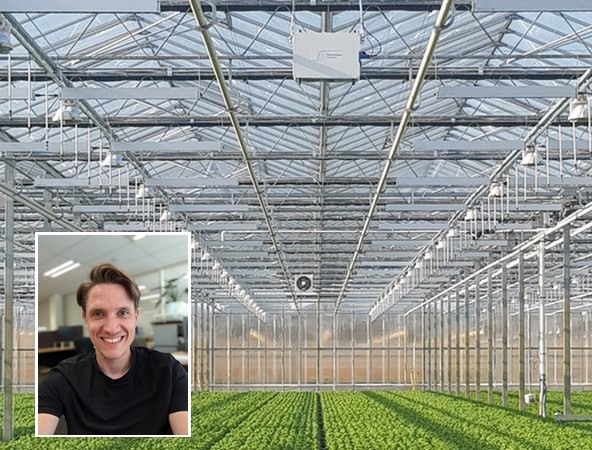By measuring the efficiency of photosynthesis of a plant, production can increase by 5-10%. However, assessing photosynthesis without damaging the plant is a challenge. Therefore, PhenoVation took on the challenge and created the CropObserver. “It can measure the plant’s photosynthesis from 2 meters high, making it the first system to do this without damaging the plant”, explains Vincent Jalink, Technical Sales Manager at the company. In this article, he explains how the CropObserver works, its benefits, and the challenge of convincing growers. 
Vincent Jalink
How does it work?
The CropObserver is hung about two meters above the crop. Previous systems had to be attached to the actual plant itself, which causes damage to the plant. Therefore, the CropObserver use a laser, which makes it possible to measure from a distance. By using a computer-controlled mirror system it measures a different area of the crop every five seconds. All locations are measured and checked on fluorescence intensity. From this data the efficiency of photosynthesis is calculated.

The CropObserver
Listening to the plant’s needs
According to Jalink, the CropObserver allows for a unique opportunity to listen to the plant’s needs in real-time, which provides the grower with beneficial knowledge. “It provides growers with the knowledge of whether they are not giving enough light for optimal photosynthesis, or perhaps the plants are receiving too much light. The system can also determine whether and when the plant has recovered from the stress that light has put on the plant.” The majority of the other sensors that are currently used in greenhouses are not “listening” to the plant itself, but are focused on the environment, such as the temperature. “Growers often make assumptions based on the way a flower looks, but this is always in hindsight. The CropObserver makes it possible to know in real-time how the plant is doing, and what can be done to improve its productivity.”
5-10% more production
On average it is possible to increase production by about 5-10% just by measuring the efficiency of photosynthesis. “What we often see is that growers are scared to burn their plants and thus give about 80% of the light they could be giving to their crops.” On the other hand, it is also possible to save energy and prevent burning. “We recently had a client who realized that the plants were given too much light. The leaves were thick and kept restoring quickly during the night, so he had never noticed that they were being damaged. As a result, he is now able to save around 5 megawatts of energy per day and optimize his production.”
Challenges
According to Jalink, the biggest challenge in creating the CropObserver has been the fact that it is able to measure photosynthesis from a relatively large distance. “We are the only company with a system that manages to measure the plant’s efficiency of photosynthesis from a distance, as these are such small quantities of light that it is really complex to optimize this ability.” In addition, it has been a challenge to convince growers that the investment is worth it, as it is a new and innovative product. “The majority of our CropObservers are currently used by universities for research, but we see a lot of future potential for growers. It is now our goal to convince them of the major advantages that the CropObserver can provide.”
For more information:
PhenoVation
Vincent Jalink
vincent.jalink@phenovation.nl
www.phenovation.com
https://www.linkedin.com/in/vincent-jalink-b8342522/
